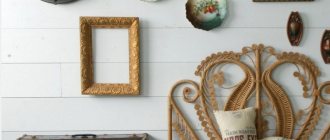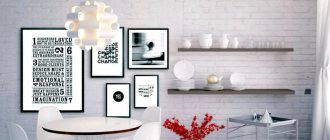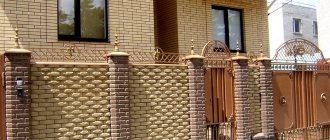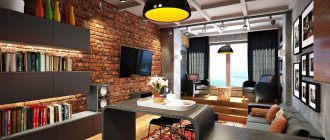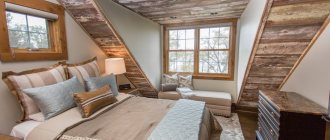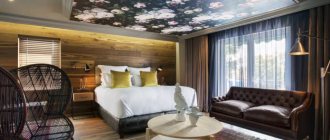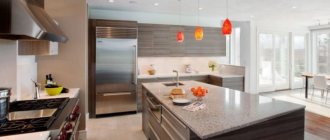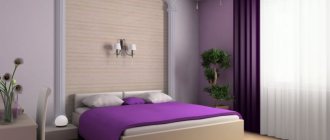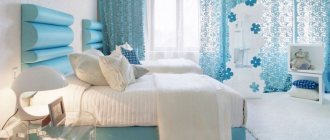Choosing material for a room with decorative brickwork
There are many offers of the necessary material on the market and each of them has its own advantages and disadvantages.
A natural stone
If the apartment is located in a new building, then the walls do not need to be subjected to extensive processing. A little cleaning of dirt and covering the walls with a special protective agent is enough. If the building is old, then it is necessary to remove the plaster from the walls and also treat it with mortar.
As a rule, they immediately attract attention and become the main decorative element of the interior.
Fake diamond
Facing. This type of stone is used exclusively for decorative purposes, because clear shapes, textures and uniform shades look tasteless as an ordinary wall. Glass. Transparent and matte rectangular elements are also suitable for decoration and wall covering. They are able to transmit light and reflect it, which will make any room brighter. There are many different shades, textures and shapes of this type of brick. Veneer. Lightweight brick tiles that are suitable for simulating masonry
Its correct shape requires careful placement in the interior. Non-woven wallpaper. Their huge advantage is that they are able to imitate masonry as naturally as possible.
Easy to use. Can be repainted. Vinyl wallpapers. They can create the illusion of brick walls, but will look unnatural and sometimes even tasteless.
White additionally gives the effect of increasing space, which is important for cases where the area of the room is small
White design secrets
Living room
In the case of a non-standard room layout and remembering the use of only one plane with a brick surface, try to make it the most bizarrely shaped wall (with protrusions, niches, recesses). In this case, masonry under white brick will adequately emphasize its individuality. If the shape of the living room is standard rectangular, then the main decorative element will help determine the “necessary” surface: it will be placed on it.
The recreation area will also be located along such a wall. If there is a fireplace in the living room, then the question of choosing a surface for decoration disappears, since the area of the hearth and fireplace is always highlighted by masonry elements.
A brick wall for the living room will be an excellent solution
Bedroom
A white brick wall in the bedroom is an excellent design solution. The seemingly rough white brick accentuates the comfort and softness of textiles: blankets and pillows. Decorative elements will successfully appear against its background: panels, paintings, mirrors, wall lamps.
The advantage of the decorated area is that, despite all the “flatness” of the pure, white, “sterile medical” color, such a surface is not uniform, but is embossed and textured.
White brick wall in the bedroom is an excellent design solution
Kitchen
Decorating its interior with masonry is used for the following purposes.
- Installation of a kitchen apron. The main requirement (in addition to design aesthetics) is increased functionality, its moisture and heat resistance. Therefore, white clinker tiles are an excellent choice for the kitchen.
- Zoning the kitchen. Highlighting the dining area, the white background of the wall will favorably emphasize the bright colors of individual decorative elements.
- Installation of a bar counter or kitchen island (if space allows).
When choosing decorative bricks for your kitchen, you should take into account all the nuances of the room.
Brick wall in the bedroom: design options
Brick walls in the bedroom make it easy to emphasize the elegance and luxury of the interior. Designers are confident that it is possible to achieve an impressive effect in the interior without the use of expensive building materials and technologies. One original detail is enough and the room will be transformed beyond recognition.
A brick wall in the bedroom can, without the use of expensive building materials and technologies, emphasize the elegance and luxury of the interior, transforming the room beyond recognition.
Wallpaper with imitation brick: recommendations for use in the interior
You can use wallpaper that imitates brick in the same places as the brick itself. They are often used for zoning and are functional in any room of the apartment. Perhaps the only exception is the apron in the kitchen. Too harsh operating conditions will not allow them to last for a long time. It is also worth considering that the more realistic the wallpaper looks, the more spectacular the interior will be. When choosing a design, follow the advice of experts:
- The color and saturation of the pattern depends on the size of the room: the smaller it is, the lighter the pattern should be.
- If the wall is well lit, choose wallpaper with an imitation texture - the masonry will look more realistic. In dark places you can use smooth ones.
- It is worth imitating brickwork on all walls only in some interior design styles, such as loft or gothic. In other cases, it is better to use brick-like wallpaper to highlight individual functional areas, for example, a dining room, fireplace, sofa.
Brick walls in apartment interiors
Brick design is appropriate in both large and small apartments. Finishing methods:
Partial finishing emphasizes how strong the walls of the home are. Most often suitable for Scandinavian style.
As an accent to highlight a separate part of the wall with central objects (clock, fireplace, TV area, head of the bed). This is a separate colored block on the wall, an opening between windows or a niche.
A single wall marks out a separate, main part of the room:
- in the kitchen there is a dining area;
- in the bedroom there is a bed;
- There is a sofa in the living room.
A separate part of the wall, an arch or a bar counter is used as a decorative element.
Brickwork separates the living room and dining room, or the cooking area in a combined room, or the hallway with the hall.
Design using brickwork: pros and cons
Non-standard solutions in the interior are, of course, good. But you can’t do without pitfalls.
Firstly, the consumable material is very heavy, which makes transportation difficult and increases the duration of construction.
Secondly, there is a financial issue. Brick is not a cheap pleasure, and the prices for the services of professional workers are also not low. And thirdly, a brick wall is a rather rough and expressive element that is not compatible with all styles.
It must be used extremely carefully, having first weighed all the pros and cons.
But where there are disadvantages, there are also advantages.
Supporters of non-trivial design moves cite many reasons why you should not give up original solutions without hesitation.
- Brick in a modern interior attracts with the opportunity to create an unusual room that exudes antiquity, mystery and romance. Using the most ordinary building material, you can add a touch of creativity and easily enliven a monotonous gray room.
- In addition to its visual appeal, a brick wall is durable. By covering the surface with an impregnating composition, you can increase the service life of the finish indefinitely, until you want to change the style of the apartment again.
- Easy care and easy cleaning. If the rough surface is subject to significant contamination, for ease of cleaning it is varnished or painted in white, brown, green, red, yellow or any other color you like. If desired, the bricks and the seams between them are painted in different tones, thereby highlighting and making the masonry pattern more distinct.
- By using brickwork in interior design, you can divide the room into zones, for example, highlight a workplace or space around the fireplace. The fireplace portal can also be laid out of brick (necessarily fireproof if the fireplace is working), or lined with clinker tiles to resemble brick.
- The ability to combine the design material with other textures, such as wood, glass or concrete. The range of color solutions is also wide, from muted natural shades to bright, catchy tones.
We advise you to study - Which finish is better for doors: veneered, laminated or with PVC film
The undeniable advantages are environmental friendliness and fire safety. The refractory material is made from natural raw materials, which creates additional safety for the life of the apartment owners.
Methods of finishing a room with brickwork
As a rule, the installation of a brick wall is carried out in rooms with already erected walls. In such cases, to implement the conceived idea, all that remains is to decorate the concrete or plastered surface.
To do this, it is better to use facing bricks, the thickness of which is much less than the wall material, due to which the area of the room will decrease minimally and the load on the walls will not increase significantly.
If you plan to build a new partition in the room, then you can go one of two ways. Firstly, lay the wall out of brick and get a double-sided masonry, and secondly, build a partition from plasterboard and line it with brick tiles.
Aged masonry looks very stylish. Designers proposing to use “time-worn” brick in the interior demonstrate various photo master classes. To give the surface an aging effect, it is necessary to apply abrasions with sandpaper, knock out small indentations with a hammer drill and chip off the edges with a hammer.
Afterwards, the wall must be coated with a deep-penetrating primer, which will seal the damaged areas and prevent the material from collapsing.
White brick wallpaper in the interior
The easiest way to display brickwork is to choose wallpaper to match the white brick in the interior. A big plus for this type of finishing is that it can be done independently, without the help of specialists, which will also allow you to save some money. Another undeniable advantage is that the surface of the wall on which the wallpaper will be glued does not require careful cleaning and leveling. On the contrary, small irregularities will play a positive role.
Decor
A drawing applied to the completed masonry will serve as an independent decor. Large graphic letters, contrasting stylized pictures - for the young and daring. It is possible to apply it yourself to express your creative impulse (you will need photo wallpaper, stencils, paint, imagination)
Particular attention should be paid to the grout joints - they also carry a design message. Carrot color has amazing clarity when duplicated with white grout
Add posters or paintings - the museum of modern art is already at your home.
The technique of “destroyed edge” of masonry is widely used in zoning and is simply created for placing small decorative items, for example, candles, small unusual lamps, on protruding bricks. Any vintage, rarity items look harmonious against the backdrop of expressive rectangles. The characteristic shape and size will highlight any hanging decor or paintings, but don’t go overboard with the quantity.
White brick wall in the living room
As a background, white brick in the living room interior is especially relevant. Any furniture will suit such walls, from traditional classics to ultra-modern furniture of unusual shapes and colors. The most suitable directions for white brick are loft, minimalism, Scandinavian and high-tech.
The photo shows an example of finishing an accent wall in the living room: the brickwork is complemented by plasterboard structures that create imitation niches.
White brick in the living room interior, photo
If you decide to hang wallpaper under white brick in the living room, finding a suitable material will be much easier, since paper, non-woven, vinyl and other types of wallpaper correspond to the conditions of living rooms.
Tip: a wall with imitation brickwork will help to visually zone the room and separate the living room from neighboring interiors, especially if you are decorating a studio apartment.
Brick decoration is not always perceived as cozy, which is why it is so important to provide bright lighting in the room and not forget about the “softer” elements that complement the overall design picture. In the interior of the living room, for example, a white brick wall, you can choose modern armchairs and sofas with upholstery in a suitable color
Long classic curtains are also appropriate, as in the photo below - this is a good example of a design project with a brick wall in a modern interior:
Another original idea for using decorative bricks in a living room is facing the fireplace. The model of the hearth is not important: both a real fireplace in a traditional design and a modern artificial fireplace will look impressive when decorated with decorative brick elements.
Brick wall in different rooms
Brick in the living room
Brickwork can be successfully integrated into the interior of almost any living room. Modern TVs look great on it.
The wall immediately becomes an independent accent. Also, such a wall looks gorgeous if you install a fireplace here (the brick has fire-resistant properties).
Brick in the kitchen
For kitchen area interiors, a brick wall can be a very practical solution. Here the brick will help maintain heat and moisture resistance.
If you treat the wall with a special grease-repellent paint, the wall will be protected from ordinary kitchen dirt. This kitchen is easy to clean and looks original.
Brick in the bedroom
The bedroom is considered a place of relaxation and requires a special attitude towards materials. Here it is recommended to use only natural materials for finishing.
Brick is great for an atmospheric bedroom if you use it to decorate the wall at the head of the bed. The bedroom will become cozy and private.
Country
In country style, brick as one background wall will look perfect in the kitchen. Rooms are often decorated with brick inserts - along arches and doorways. The main feature of country style is its lightness, ease and simplicity
And it is very important not to disturb this harmony with a rather heavy brick
However, if there is room for a fireplace in the room, then a brick wall near it will add zest to the interior. Small brick inserts will go well with a simple small floral print on wallpaper and textiles. The main companion of country style is wood. Wooden floors and rustic furniture will add a real rustic feel to the interior.
We advise you to study - Living room in Scandinavian style - practical and elegant
Interior styles for brickwork
The main style in which brick is actively used for wall decoration is the loft style. Loft is now very popular all over the world. Its history began with premises in industrial zones that were converted into residential apartments.
The industrial aesthetics of these spaces were combined with traditional residential elements, giving the loft-style apartments an amazing energy of freedom and audacity.
In the eclectic style, brickwork on the wall is used as a tool to unify the space of the room.
In this style, decorators often decorate a brick wall with posters that focus attention on the owner’s preferences or the main theme of the entire interior.
Art Deco uses brick walls with a touch of history. In this style, such wall design gives the room nobility and severity.
The brick walls here are reminiscent of medieval castles, and even the presence of modern technology does not diminish this impression.
Country style is characterized by the use of traditional brick to create interiors with stoves and fireplaces.
Previously, the walls in such rooms were left without cladding, but now raw walls with exposed brickwork are becoming a luxurious element of modern design.
Gothic and neo-Gothic rightfully use brick not only for walls, but also for all kinds of arches, niches, columns, etc.
This non-trivial style contains many different contrasting elements. From crystal chandeliers to medieval canopies. The interiors are very impressive and arouse admiration even among unprepared guests.
Decorating in a minimalist style with a brick wall can be elegant and will only emphasize the very essence of the main stylistic decision.
Interior ideas
It’s worth starting with an unusual American-style interior. The brickwork was able to fit into the traditional interior thanks to the monochrome color scheme, in which gray predominates. In addition, white accents and glass bedside tables helped with this, which are not at all noticeable.
The following design is another interesting example of combining things that are far from each other. The brick wall fits harmoniously into the interior in the colonial style, since terracotta is one of its characteristic colors.
Finally, it is worth considering a minimalist interior, in which the brick creates a rather cozy atmosphere - due to the red color scheme. The predominance of white and beige colors interrupts the rich color of the brick and creates a feeling of spaciousness. Black accents are used to complete the design.
See the next video for even more beautiful bedroom interiors with a brick wall.
Advantages and disadvantages
The main function of brickwork in the interior is to draw attention to a certain area of the wall, to highlight it against the background of the rest of the decoration. What is the advantage of this material over analogues?
The advantages of using bricks are:
What is the advantage of this material over analogues? The advantages of using bricks are:
- accessibility in terms of cost;
- environmental friendliness;
- naturalness;
- high sound and heat insulation performance;
- moisture resistance;
- decorative;
- texture;
- originality;
- durability;
- simple installation - it is enough to have a minimum set of construction skills and simple tools;
- functionality - in addition to the decorative function, it can serve for zoning or delimiting rooms;
- strength - hanging elements - appliances, shelves, lamps, decor - are securely fixed on it;
- self-sufficiency - additional coating treatment is not necessary;
- excellent ability to mask existing base defects.
Disadvantages of a brick wall:
- The need to organize high-quality lighting for untreated brick masonry. This drawback can be mitigated by painting or using white material.
- An excess of brick in the interior creates the effect of a neglected and uncomfortable room that lacks home warmth.
- A textured surface covered with bumps and cracks is difficult to care for.
Advantages and disadvantages
Any finish has its strengths and weaknesses. Let's get to know them before we start implementing our ideas.
Advantages: accessibility and simplicity
The undeniable advantages of using brick in the interior include:
Disadvantages: the main thing is to stop in time
There are quite a lot of advantages to this type of finishing. But what are the disadvantages?
The disadvantages of a brick wall in the interior of a house include:
Brick finishing in the interior of apartments: photos
1
Two-room apartment 57 sq. m.
In the design, the wall in the living room, kitchen, bedroom, as well as the bar counter separating the living area from the kitchen are made of decorative “aged” brick.
Photo of the design project “Loft style apartment 57 sq.m. m."
2
Studio 25 sq. m.
In order to avoid the high costs of renovating the studio, the walls were painted and the furniture was purchased from IKEA. In order to enhance the decorative effect, the wall near the sofa and bed was stripped down to the brickwork and painted white.
photo of the design project “Studio interior 25 sq. m."
3
Duplex apartment 82 sq. m.
The design is designed in a loft style; instead of natural brick, a decorative but natural color is used. In order not to overload the interior, some of the walls were painted.
4
Two-room apartment 40 sq. m.
After the restoration work was completed, walls made of old brick were visible. This became the main interior in the loft style.
White brick walls provide the perfect backdrop for a cozy relaxation area.
5
Two-room apartment 114 sq. m.
The designers helped create a brutal interior using finishing materials - natural wooden boards on the floor, red brick walls and wooden furniture.
Photo of the design project “Brutal interior of an apartment in London”
6
Three-room apartment 155 sq. m.
The original design of the apartment is made in bright colors. Wall decoration uses brickwork, painting, wallpaper, mosaics, and even the greenery of living plants. The combination of colors and textures is chosen so that all this variety fits perfectly and forms a harmonious and cozy interior.
Photo of the design project “Interior of an apartment 155 sq. m. from Studio Stern"
Decorative brick in the interior - choosing a color
Top 50 best interiors of the outgoing year: painting walls in an apartment, design, photos of sophisticated techniques
Three factors determine the appearance of the base made of decorative or facing bricks for interior decoration in the interior:
- type of masonry (chain, Gothic, Dutch, Flemish, cross, bonded, spoon, chaotic);
- finishing method;
- shade of building blocks.
Designers often offer an unexpected solution, not only within the terracotta-reddish range or white silicate blocks. Most of this palette is presented in other, no less interesting proposals, depending on the inclusions and production technology of the material.
Brick goes well with graffiti
The following colors look most impressive:
- white;
- grey;
- black;
- ocher;
- sand;
- pistachio;
- terracotta;
- chocolate;
- straw.
Depending on the design concept, the brick wall can even be blue, green or black. This is justified if, for example, they use a background for spectacular graffiti in the loft style or for other aesthetic tasks that involve “bricks”.
White brick is well suited for interior design in a minimalist style
Separately, it is worth noting the white color, it is appropriate in any room, visually expanding the space and adding light. If you were unable to find a suitable material, this will not be a problem if you paint the masonry in light colors. There will be more light, but then the natural material will not “breathe” under the film, absorbing and releasing excess moisture.
Gray color looks modest, and at the same time aristocratic. Experts value it as an excellent background for exquisitely shaped mirrors and other original decor in an elite setting.
Neutral gray color will create a calm background for decorative elements
The material differs in texture:
- glaze coating;
- smooth baked;
- chopped;
- chopped;
- wild;
- rocky;
- marble, etc.
The surfaces are most often smooth matte, but it is possible to choose cladding with a glossy end or with a rough texture. Whitewashing or painting over real masonry is the best way to update without resorting to major repairs. You can paint it any color, but a little darker than the shade of the brick itself, so that there are no bald spots.
Interesting combination of smooth surface with exposed brickwork
Aged brick does not have to be hidden under a layer of plaster if the base is laid out very skillfully. Designers suggest removing the top layer or selecting building materials with the same effect. Old brick left over after renovation can also be used for purely practical purposes. All that remains is to re-fold the wall, soaking it with colorless varnish. The treatment will make the surface more amenable to cleaning.
To be convincing, for decorative purposes, the laid base is slightly destroyed - it is modified with a chisel, files, a blowtorch, construction acids and other means.
Exposed masonry should be coated with a protective varnish
Any design project involves a stylistic decision. In a modern solution, a plasma panel on a brick wall in the living room interior is the main accent; in a classic English office, it is better to hide it behind a rotating picture. This is a universal decor in many styles:
- grunge is a typical retro of the French bourgeoisie, who value comfort and quality things that have stood the test of time, here time seems to have frozen (crumbled brickwork as a mute witness to past luxury);
- fusion is a product of eclecticism, where classical features are recognizable in a modern reinterpretation);
- in a Scandinavian interior, a white wall is perceived most organically;
- neo-Gothic - an excellent solution with a black wall for high ceilings;
- excellent find in country and Provence style, only light unfinished plaster and whitewash;
- hi-tech - his “ode to high technology” goes well with this brutal finish;
- classic presupposes skillful finishing, the hallmark of the style is a fireplace with open masonry.
Brick walls are suitable for many styles
Brick in the interior of a room: in which rooms is it appropriate?
Elements of brickwork can be fitted into a room for any purpose, from the entrance area to the bathroom or toilet. The main thing is to choose an option that will fit perfectly with the furniture and the rest of the decoration.
Hallway
Here, brickwork will help separate the entrance area from the rest, either with a rich brick texture on the walls, or with a free-standing partition made of bricks, if the area allows. You can decorate with masonry a section of the wall in the hallway reserved for a clothes hanger, thereby separating it into a separate area. Console tables for gloves and other small items, above which a large mirror is hung, look impressive near a brick wall.
The photo shows a brick wall in the hallway in the interior of a 56 sq. m studio. m.
Kitchen
Most often in the kitchen, brickwork serves as an “apron” near the work surface. Here, as a rule, decorative bricks are used, which have special characteristics and a smooth surface, which makes cleaning easier.
Also in the kitchen you can highlight a dining area, a bar counter, and an island table with masonry.
The photo shows a bar counter decorated with red brick. Project from Litvinov design “Loft style in the interior of a compact studio.”
Living room
A brick partition can separate the living room area from the rest in an open-plan apartment. In addition, false columns are lined with brick and a wall is laid near the fireplace. The masonry also marks out a sofa or TV area.
The photo shows white brick in the interior of the living room. Project: “Design of a two-room Khrushchev house 45 sq. m."
Bedroom
Here, brick is most often used to decorate the wall at the head of the bed, emphasizing its special significance in the interior with its texture. Another popular option is to accent a wall with a window with masonry. In small rooms, it is better to brick not the entire wall, but only part of it, so as not to burden the perception of space.
We advise you to study - Cement particle board - characteristics, properties, types, application
The photo shows red brick in the bedroom interior. Project: “Design of an apartment in white tones, 90 sq. m. m."
The photo shows white brick in a modern style bedroom interior. Project: “Apartment design in light colors from Hola Design”
Plumbing facilities
Brick can also be used in bathrooms and toilets - there are no restrictions, the material can withstand both elevated temperatures and humidity. Brickwork distinguishes different zones in the room, or separates them with partitions.
The photo shows white brick tiles in a bathroom interior. Project: “Loft style in the interior of an 85 sq. m. apartment.” m."
In addition, large apartments and private houses can be successfully complemented with brick arches, or walls near staircases and landings can be lined with brick.
Brick in the bedroom: features, photos
The vacated factory premises began to be adapted for housing, and brick walls were used in the interior in order to avoid the significant costs of bringing them to their usual appearance. This is how the loft style was born, which over more than a century of its existence has become as familiar as empire or classic, and brick in the bedroom no longer seems strange or too “hard” material.
Loft has penetrated from former factory buildings into the most elite residential buildings; now entire apartments and individual rooms in them are decorated in this style.
Brick as a finishing material brings brutality, power, and courage to any interior. This is more likely masculine material, or material for strong women who are not afraid to take responsibility. Brick in the interior is also used in other styles, such as minimalism, Scandinavian or country.
A brick wall in the bedroom will add originality and expressiveness and help you express yourself and your character. And it is not at all necessary that the wall is actually brick. You can create an imitation of masonry using various materials; this allows you to choose the color, thickness of the seams and size of the “bricks” you need, unlike a real brick wall, where all this is rigidly specified.
It is enough to decorate at least one of the walls with brick in the bedroom - and the room will immediately change, its style and mood will change.
Typically, the most visible wall in a sleeping area is the one next to the bed. So for “brickwork” it is wise to choose the wall at the head. The color of the “bricks” must be selected in accordance with the overall color scheme of the room. For example, “red” brick goes well with a natural-colored wooden floor.
A brick wall in the bedroom can be painted in the same tone as the rest of the walls, or in a contrasting one, in this case becoming the central point in the interior, from which all other decorative designs will be built.
Both real masonry and its imitation can be painted in almost any color. The advantage of real bricks is their rich texture. To preserve and emphasize it, pure white is often used, which also helps to visually enlarge the room.
Of course, when using brick in the bedroom as the main decorative element, you should think about supporting the chosen style with other details. At the same time, it is very important to observe a sense of proportion so as not to make the corner of your home intended for rest and relaxation too hard and rough, unsuitable for fulfilling its purpose.
Photo in the interior of a country house
The interior of a country house has more opportunities for realizing ideas. A simple fireplace with a concrete cladding will look gorgeous. The contrast of cold and hot will look impressive in the interior of the living room.
The photo shows a living room in the interior of a country house. The niche, finished with concrete panels, is fully utilized, combining a fireplace, a seating area and a place for logs.
With the help of concrete columns or small partitions, you can divide the space into zones without compromising the area, without interfering with natural light.
A minimalist staircase with railings is suitable for both classic and modern interiors.
How to choose?
For street decoration, this finishing option will be unacceptable. For external decor, a similar material was invented - gypsum cement tiles, visually indistinguishable from gypsum tiles. Therefore, if you set out to improve the exterior of your home, take the trouble to find out about the composition of finishing materials in more detail.
Materials that imitate bricks are increasingly used for interior decoration. Masonry goes well with many styles, and due to the variety of colors and textures, the question of choosing a specific finishing material arises.
If your room is designed in a loft style, then a large space, at least one wall, should be occupied by brick. The color should be as close as possible to the color of natural brick - all possible shades of the ocher-red spectrum. The size of the bricks is approximately 6 by 12 centimeters.
The romance of village life is best emphasized by the combination of brick and wood. A brick wall could be painted to imitate lime over the textured exposed bricks.
Brick goes well with the Gothic style - wrought iron elements and massive furniture, stained glass windows and a fireplace. Decorative plaster and crystal chandeliers will also fit quite harmoniously into such an interior.
Minimalism is characterized by large areas of masonry and a minimum of details. Bright color accents are welcome.
The decorative texture, reminiscent of a brick, is a worthy alternative to textured wallpaper with a “brick effect”, decorative plaster, plasterboard, real bricks, and their facing options.
It is possible to make tiles yourself. For this you will need a plaster mixture, a silicone mold, a flat surface, colors, matte acrylic varnish, brushes and a spatula. If you follow all the recommendations for making the product, you will never have problems choosing the piece of masonry you are interested in.
Fireplace area
Fireplaces are associated with country holidays, and now they are boldly erected in city apartments, giving additional comfort
It doesn’t matter in which area the fireplace is located: bedroom, living room, kitchen-dining room, the brickwork will fit organically and enhance the local effect of the presence of the fireplace. Natural colors and textures will emphasize the brightness and naturalness of the flame if the fireplace is electric
Combining a fireplace and a brick wall is acceptable within a single style, such as country. The decorative finishing of portals can be played out in contrast or done in the same color scheme, for example, against the background of light clinker, a hearth trimmed with black marble looks impressive. The central decoration of any room will be a fireplace portal, lined to the very ceiling, against the backdrop of a vertical plane of snow-white brick in the Provence style. Brickwork is ideally combined with forged products, which are used in abundance to decorate the fireplace area.
